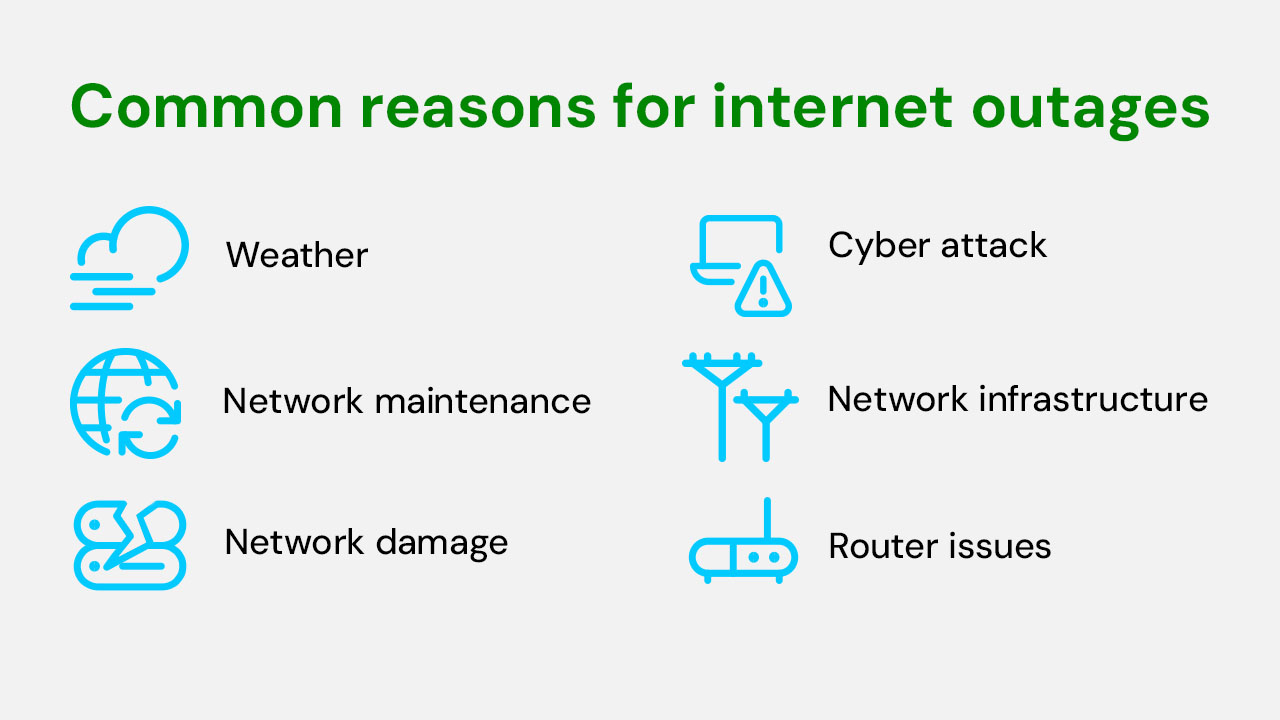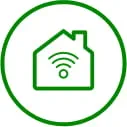Few things are more frustrating than opening a web browser or turning on a smart device and getting a “no connection” notification. We’ve come to rely on the internet for almost every aspect of our daily lives, from streaming music to working from home. So when it goes down, we’re understandably frustrated. What’s the deal?
How the internet works
How your internet works depends on what kind of internet you have. For the purposes of this article, we’ll briefly talk about the two most common forms of internet connectivity: cable and fiber.
Cable internet uses copper coaxial cables (you don’t need to worry about what that means) to transmit electrical signals to transfer data. Cable is an older technology that’s still widely used but quickly getting replaced by the more future-oriented fiber internet. Fiber uses strands of glass to transmit data via pulses of light. It’s newer, more reliable and usually faster than cable, with symmetrical upload and download speeds. That means that you experience less lag and fewer aggravating buffering wheels and delays.
With the advent of fiber, we’re seeing much more reliable internet connectivity and speeds virtually as fast as light itself. This is critical, as so much of what we do every day necessitates a fast, reliable internet. Gone are the nostalgic days of dialup, with the squeaky door, a “you’ve got mail” alert and painfully slow page loads. The internet is not a novelty anymore. It’s the basis of most of our society. That’s all to say, we need it to work.
Why is my internet down?
Why, with all the technology available now, would your internet go down? Shouldn’t it be like water? When you turn on the faucet, the water comes out. Simple.

Weather and natural disasters
Just like electricity, which often goes out during a storm, when the internet drops out it’s often due to inclement weather. Since internet lines are usually connected aerially to utility poles alongside electricity and telephone wires, when a pole goes down, so goes the internet.
Construction
The other way a fiber internet connection gets to your house or business is through the ground. When wires can’t be connected to poles for whatever reason, internet companies will bury them underground. Builders, construction crews and residents are supposed to call before they dig to be sure they don’t hit an electrical or natural gas line, but unfortunately accidents do still happen. When someone digs and hits a fiber-optic line, it can affect your service until the technicians get it reconnected.
Vandalism
Unfortunately, there are bad actors out there who take pleasure in breaking nice things. Sometimes they have a motive, like looking for copper to sell. Sometimes they just like to break stuff.
Cybersecurity attacks
Also rare, but related to vandalism, are attacks by cyber criminals who either want to steal something or just wreak havoc on a company. Distributed Denial of Service (DDoS) attacks, in particular, can overwhelm a network's servers and cause downtime. ISPs invest in robust security measures to fend off these attacks, but they can occasionally succeed in disrupting internet service.
DNS problems
The Domain Name System (DNS) is responsible for translating human-readable web addresses into IP addresses that computers can understand. When DNS servers experience issues or become overloaded, it can result in difficulties accessing websites. This often leads to a perception of a "down" internet, even when the connection itself may be functional.
Equipment failures
Routers, modems and other networking devices can fail due to technical malfunctions, overheating or other issues. Equipment failures can result in a loss of connectivity or intermittent disruptions. Regular maintenance, following device instructions, rebooting your modem or router and running upgrades can help mitigate the risk of these failures.
Software issues
While fiber internet connections are known for their reliability, software issues can still impact the service. Problems with the internet service provider's (ISP) infrastructure, such as configuration errors or software bugs, can lead to network outages. ISPs work tirelessly to keep their systems up to date and secure, but occasionally, software issues can cause temporary service interruptions.
Planned Maintenance
Internet service providers (ISPs) may schedule maintenance and upgrades to their networks, which can lead to temporary service disruptions. They usually inform their customers in advance to minimize inconvenience.
Network congestion
One of the most prevalent causes of internet slowdowns is network congestion. When too many users in the same area or on the same network simultaneously demand high bandwidth for streaming, gaming or downloading large files, it can overload the network's capacity. This congestion leads to slowdowns or, in severe cases, a complete loss of connection.
Cable connections are much more susceptible to network congestion than fiber. Fiber internet utilizes dedicated connections, which means that the data coming to and from your devices is on its own path. That frees up bandwidth and radically reduces slowdowns and lag.
Fiber-optic internet is more reliable
Fiber internet can still go down, but it’s more likely to be due to something out of your control, like a construction or weather-related disruption. At Ziply Fiber, we operate below capacity, which means that there is always more room for data than necessary, so you don’t experience slowdowns due to network congestion.
How does fiber internet get installed?
How to avoid an outage
Switch, if you can, to a more reliable provider, and choose fiber internet if it’s available. It’s not only more resilient, it’s also just a superior, future-proof technology. Also ensure that your software and security devices and programs are up to date.
When external elements cause an internet outage, your internet provider should be quick to notify you of the outage and keep you updated on the repair process. Whenever you experience an outage, try rebooting your router or modem by powering it off for one minute. If there’s a more serious problem, contact your ISP’s help center for assistance.
If you’re not receiving notifications from your ISP, check to see if you opted out of communication or if you have changed your phone number or email since you signed up. Now’s a good time to update your contact information and to opt into SMS and email communication, so that if service goes down, you’ll be in the know.
Most of the time, ISPs work around the clock to fix outages, but some can be more complicated than others. If your internet is down and you don’t have WiFi, you may be able to use your phone’s cellular data to connect to the internet, so that at least you can communicate with the people in your life — or check in with your ISP to see when it will be back up.






